Please read:
It is not my wish to offend anyone with this posting. If you are troubled by the pictures I have put up or what I have wrote, please know that I only mean to share what I have learned.
Your feelings of discontent are normal. No one should feel comfortable looking at this post.
Most importantly- remember that these are actual events that took place in our world not even 100 years ago.
Thank you.
I watched Schindler's List last night for the first time since I was a sophomore in high school. What a fantastic work of art, that movie is. There is a scene where Oskar Schindler is confronting the camp commander Amon Goeth, asking him what a life is worth to him. Goeth then responds by asking Schindler the same question, but with skepticism on his intent of insisting that he have the Jewish workers that he is so persistent of obtaining. This scene made me reflect on the journey I embarked on the day before, in which I participated in a class trip to the Auschwitz Concentration Camp and Birkenau Extermination Camp.
What is a life worth?
We arrived in Krakow, Poland on Saturday, the 9th. The city was calm and I felt as though the devastation it faced over 70 years ago was still lingering in the streets that lost so much of it's culture that the Nazi party had forcefully taken away. What would the city of Krakow be like today if it still had it's once proud Jewish population?
On Monday, November 11th, we spent our day going through the camps. It was a long and exhausting day, both physically and emotionally. I felt physically ill and drained from the day, and have since had a cold (I am not making this up).
I post these photos and descriptions with a heavy heart, and a desire that people will be able to learn more about the events that took place.
Note: Some pictures will be out of order. I apologize for the inconvenience.
 |
"Work Sets You Free"
This is not the original sign, but an exact replica. The original sign was stolen by Neo-Nazis who were eventually apprehended, but the sign had been destroyed. In an effort to keep the museum alive, this replica was created. |
 |
| Walking down the row of blocks, stopping in a few to view the museum exhibits. As I walked down this path, I thought about the countless prisoners who walked the same steps, but not bundled up in a large coat, warm hat, and weather resistant shoes as I was. I had only imagined what it was like to be inside Auschwitz, and it finally became a reality. How strange it was, that I was walking into each of these blocks out of harms way while they walked the same road to, in some cases, meet their death. A harsh and bitter reality. |
 |
| Prisoner clothes. These clothes would often be infested with lice after a short while, and provided little to no warmth to the people wearing them. |
 |
| A guard tower at the end of a row |
 |
| This couple spent some time here at the wall outside of Block 11 where many prisoners were shot. |
 |
| This wall, like the entrance sign, is not the original. The original wall was destroyed after the war, and this wall was put in place to commemorate those who were murdered at this site. |
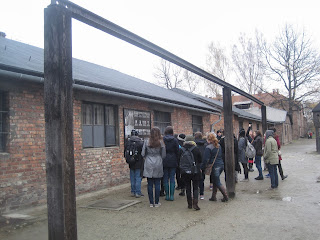 |
| Political prisoners were once hung here to taunt the rest of the prisoners who walked past |
 |
| In the cold of winter, guards would sit in a shelter, such as this one, while the prisoners gathered outside in the cold, dressed only in their stripes and wooden clogs. |
 |
| The barbed wire at Auschwitz was deadly and kept the prisoners from fleeing. Barbed wire only has a lifespan of about 2-3 years. It is continually replaced by the museum to keep the memorial alive, causing major financial implications. The museum is on a never-ending financial battle to keep Auschwitz I and Auschwitz II-Birkenau intact. |
 |
| Gallows where prisoners would be hung |
 |
| Inside of a gas chamber at Auschwitz I |
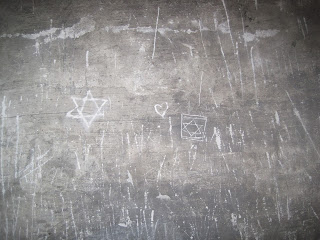 |
| Yes. Those are scratch marks. |
 |
| Auschwitz II- Birkenau |
 |
| Prisoners would enter the camp by train through the gate, and be forced out of the train cars, having to make a leap of about 4 feet to the ground. Some of these people would break a leg from the impact, and would be as good as dead right there on the spot. Young, old, men, women, and children. |
 |
| A guard tower watching over the barracks |
 |
| At first, barracks were made from brick. These barracks were not professionally built, but instead created on slave labor by the unqualified prisoners. The Nazis decided that this was too much of a financial burden, and started having the prisoners build them out of wood. The chimneys show where the barracks once stood, but were burned down at the end of the war. There are now only ruins that stretch great distances of the camp. |
 |
| A barrack built from brick |
 |
| Bunks were made from planks of wood. No mattress, no pillow. Prisoners would often use a clog as a pillow, otherwise end up keeping their clogs close at night to avoid the risk of having them stolen by other prisoners who were desperate. Lose one pair, you would not get another. The bunks were cramped, fitting up to 5 people on one bunk. It was much preferred to have a top bunk. Howcome? As my professor put it- "Heat rises, Shit falls". Having a bottom bunk meant that you were at risk of getting covered in human feces at night, having your belongings more easily stolen, and would be far colder than you would be on the top bunk. |
 |
| This is no average pond. |
 |
| It is filled with ash of human remains. May they rest in peace. |
 |
| The Germans blew up 4 of their 5 crematoriums at the end of the war. This is Crematorium #1, right beside the ash pond. |
 |
| After leaving their belongings on the ground outside the entrance, prisoners would be forced down the stairs into this room where they would undress down to their naked flesh, lining up for their imminent death. At the end of the room and to the right is where they would be led- the underground gas chamber. From this point, they would be barred in by camp guards. Guards would then open a hatch at the top of the gas chamber, and throw in cans of Zyklon B, a cyanide-based poison which would make the prisoners unable to breath, causing them to suffocate and die. From this point, the bodies would be moved to the Crematorium right outside. The belongings would then be moved by truck to an area of camp known as "Canada". |
 |
| A memorial erected after the end of the war by the Soviet Union. Under this memorial lies bones of victims killed at Birkenau. |
 |
| The same message is spelled out over and over again in many different languages. |
 |
"For ever let this place be a cry of despair and a warning to humanity where the Nazis murdered about one and a half million men, women, and children
Mainly Jews from various countries of Europe
Auschwitz-Birkenau
1940-1945" |
 |
| A monument at the memorial |
 |
| Another Crematorium |
 |
| A picture of the Crematorium above, when it was still intact before being destroyed by the Germans |
 |
| My professor pointed out the woman in the black headscarf with the glasses to the left. She knew what was in store. |
 |
| The undressing-room and gas chamber beside the Crematorium |
 |
| Walking further into the camp |
 |
| This is a man-made ditch. The area of Birkenau camp is a marshland, and the Nazis decided to have the prisoners dig trenches as means of drainage. These were dug mainly by political prisoners and criminals year round, even when the water was at the bitter cold temperature of around 32 degrees. No boots or warm clothes were provided to these prisoners, who would sometimes be forced to go dig while wearing just their underwear. |
 |
| A picture outside the trench of prisoners at work. |
 |
A beautiful terrain...to the unknowing eye. "I could go out there, stick my hand in the ground, and find human bone" my professor explained to me as he revealed that this site is likely the largest mass grave in all of Europe. Around 300,000 bodies were disposed of in this meadow, which back in the day was a large mud pit filled with bodies. The bones were crushed up into small bits, and can easily be found on the surface of the ground. After just 2 minutes of searching, I came across what I thought was a small pebble. I brought it to my professor only to find out that it was, in fact, human bone. A terrifyingly peaceful place, where forest animals spend their mornings.
|
 |
| Beside the mass grave is the ruins of an old house. Germans forced inhabitants of the area out of their homes, air-sealed them, and turned them into make-shift gas chambers. Hundreds of people would be shoved into this one particular house, some people being thrown on top of the crowd already inside. |
 |
| More memorial plaques in memory of those who lost their lives during the Holocaust |
 |
| "Canada". This is the area where stolen goods were stored, before and after their rightful owners had been terminated. There once stood barracks where the possessions were stored, but like much of the rest of the camp, was burnt to the ground. In 1995, Pope John Paul II was coming to give a speech at this very spot. The grass had not been taken care of since the end of the war, which was a necessary preparation for having the Pope come to speak. While mowing the grass, the museum workers discovered that there were still hundreds of items that were melted into the ground, previously covered by the tall grass. Many of the items have since been cleaned up, some sitting in the middle of "Canada" under a glass enclosure. However, walking around the area, my classmates and I were able to find parts and pieces of different possessions that once belonged to those who lost their lives. |
 |
| Zyklon B |
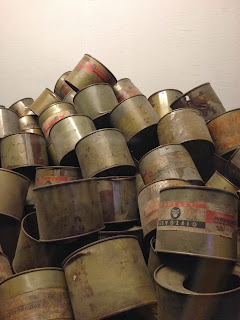 |
| Empty cans of Zyklon B that were found after the war |
 |
| This picture was not an easy one to post. In fact, I was not supposed to take this photo at all. I do not want to sugarcoat it, or downplay how substantial this picture is. To be frank- you are looking at mounds upon mounds of real human hair. Over two tons of hair lie behind the glass enclosure at Auschwitz I. Witnessing this was very difficult, and left a very bad taste in my mouth. It is my hope that my posting of this picture does not offend anyone, but instead give a more sense of reality of the crimes committed. |
 |
Glasses. Looking at these may not mean much, but it is important to consider one thing:
Each pair of glasses belonged to a person who lost their life at Auschwitz I |
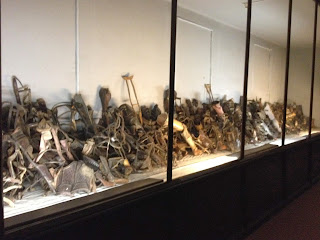 |
| Back braces, crutches, artificial legs, and more. |
 |
| More miscellaneous possessions of the prisoners. Pots, and such. |
 |
| Thousands of pairs of shoes lie behind the glass enclosure that lines the wall all the way down the long room. |
 |
| Suitcases marked by prisoners who thought their belongings would be delivered to them, but were instead emptied out and sorted. |
 |
| An illustration can only do so much. |
 |
| These are real people |
 |
| Who perished at Auschwitz I |
 |
| May they rest in peace. |
 |
| A small selection of the pictures which line the hall in part of the museum |
 |
| A survivor who was found in this condition. People such as this were under extreme medical care on their way to recovery. Our guide explained that one woman who entered the camp at around 75kg (165lbs) was found after the war weighing around 20kg (45lbs). |
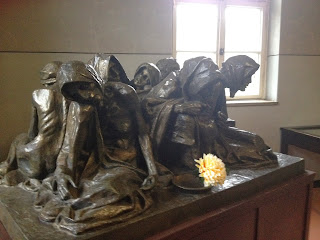 |
| A memorial to those who faced starvation |
 |
| Illustrations of camp life by a survivor |
 |
| Children's clothing. No one was spared. The Nazis did not care how young or old these victims were, they were all seen as "vermin". The kids did not stand a chance because they were only seen as illegitimate workers to the Nazis. |
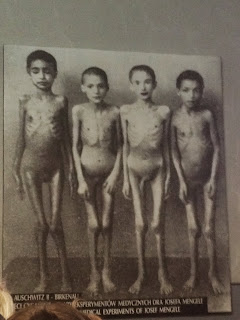 |
| Children who were chosen for medical experimentation by Nazi doctors |
 |
| A memorial for the young that perished in the camp |
 |
| More marks in the gas chamber at Auschwitz I |
 |
| Furnaces where the bodies were burned |
 |
| If you were forced out of your home, what would you bring? These people loved their families very much, which meant that in the harsh rush of choosing belongings before being shoved in the ghetto, most of them took pictures of their families with them. The Nazis were very organized, and their use of organization is responsible for many terrible things. These findings, however, are one good use of the organization of the Nazis, making the number 6 million a lot more personal. |
 |
These two pictures are two of the few that have been discovered from action inside of the camp. It was highly illegal to take photos inside of the camps, and very difficult for the film to have a way to be developed. Seeing these photos now means that someone was able to take them, get them out of the camp, and have them developed somewhere in the city.
In this picture, women are being forced to undress in the woods and are running toward the nearby gas chamber. An eerie feeling rose over me when I was told that we were in the area where this photo was taken. |
 |
In a rush, the Nazis decided to have more trenches dug on the outskirts of the camp, deep in the woods. It is here that bodies would be thrown in and burned. Prisoners would then be forced to scrape up the fat from the burnings, and throw it on top of the next fire to fuel it under the open sky. The smell of smoke filled my nose in the dewy weather.
It was not my professor's cigarette. |
 |
| Another crematorium that was not completely destroyed. |
 |
| Remains of the furnace in the crematorium |
 |
| Black. This, like the pond previously mentioned, is no typical pool of water. This is the largest ash lake at Birkenau Camp. |
 |
| Families gathered in the woods waiting to be forced into the gas chamber. These people were well aware of what was going to happen. Just down the pathway, people were entering the crematorium (above), and not coming out. One of the most terrifying parts of this journey through the woods was when I learned that these families were sitting in the exact spot that the picture was posted in, in those trees just behind the photo-post. |
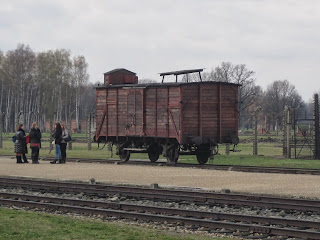 |
| A train car that transported prisoners into the camp. These were stoked full of people who were physically unable to sit or stretch. Sickness and disease would be a problem in these cars, while they transported prisoners on long, multi-day trips. No food, no water. |
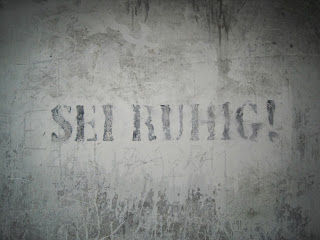 |
| "Be Calm" |
So what
is a life worth? To Oskar Schindler, it ended up meaning so much more than to the other members of the Nazi Party. He was different from the rest of the Nazi Party members, and saw the Jewish people as more than "vermin", but as people. Some of my greatest friends are Jewish, and I cannot imagine a world in which they were never here.
I want to thank you for your time and ability to make your way to the bottom of this post. Whether or not you felt uneasy after getting through it, know that it was not an easy task for me to put these up and write the descriptions of such terrible acts.
Let this be a respectful reminder of what happened in Europe from 1940-1945, and a tribute to what our soldiers did to put an end to what I have posted above.
In memory of those who lost their lives during World War II.
Respectfully Yours,